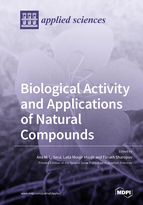Biological Activity and Applications of Natural Compounds
A special issue of Applied Sciences (ISSN 2076-3417). This special issue belongs to the section "Applied Biosciences and Bioengineering".
Deadline for manuscript submissions: closed (29 February 2020) | Viewed by 75840
Special Issue Editors
Interests: bioactive natural compounds; secondary metabolites; chromatographic techniques; spectroscopic techniques; natural compounds
Special Issues, Collections and Topics in MDPI journals
Interests: antimicrobial activity; secondary metabolites; biological evaluation; cytotoxic activity; mechanism of action
Interests: Natural products; medicinal plants; isolation active compounds; essential oils; biological activity; cytotoxicity; antioxidants; chromatography; sorption; adsorbents; drug discovery.
Special Issue Information
Dear Colleagues,
Natural compounds, also known as secondary metabolites, obtained from terrestrial or marine species, are a research focal point, both from the point of view of isolation and structural characterization of new molecules that can be valuable scaffolds, as well as from the point of view of applications of these molecules in the pharmaceutical (e.g., to treat cancer, cardiovascular and infectious), food (e.g. as additive), cosmetic (e.g. as proposal of smart-aging), and environmental industries, among others.
As Guest Editors of this Special Issue of Applied Sciences “Biological Activity and Applications of Natural Compounds”, we invite you to provide original research contributions, as well as review articles, related with pure and completely characterized secondary metabolites from plants, seaweed, and sponges. Specifically, this issue will focus on the potential of these metabolites as therapeutic agents (due to their in vitro and in vivo antitumor, antioxidant, anti-inflammatory, anti-neurodegenerative, antimicrobial, and anti-aging activities) as well as environmental health agents and nutraceuticals.
We look forward to receiving your contributions to this Special Issue.
Prof. Dr. Ana M. L Seca
Prof. Dr. Laila M. Moujir
Prof. Dr. Farukh Sharopov
Guest Editors
Manuscript Submission Information
Manuscripts should be submitted online at www.mdpi.com by registering and logging in to this website. Once you are registered, click here to go to the submission form. Manuscripts can be submitted until the deadline. All submissions that pass pre-check are peer-reviewed. Accepted papers will be published continuously in the journal (as soon as accepted) and will be listed together on the special issue website. Research articles, review articles as well as short communications are invited. For planned papers, a title and short abstract (about 100 words) can be sent to the Editorial Office for announcement on this website.
Submitted manuscripts should not have been published previously, nor be under consideration for publication elsewhere (except conference proceedings papers). All manuscripts are thoroughly refereed through a single-blind peer-review process. A guide for authors and other relevant information for submission of manuscripts is available on the Instructions for Authors page. Applied Sciences is an international peer-reviewed open access semimonthly journal published by MDPI.
Please visit the Instructions for Authors page before submitting a manuscript. The Article Processing Charge (APC) for publication in this open access journal is 2400 CHF (Swiss Francs). Submitted papers should be well formatted and use good English. Authors may use MDPI's English editing service prior to publication or during author revisions.
Keywords
- Natural compounds
- bioactivities
- industrial applications
- drug discovery
- nutraceutical
- environmental health
- anticancer
- antioxidant
- anti-aging
- structure-activity relationship








